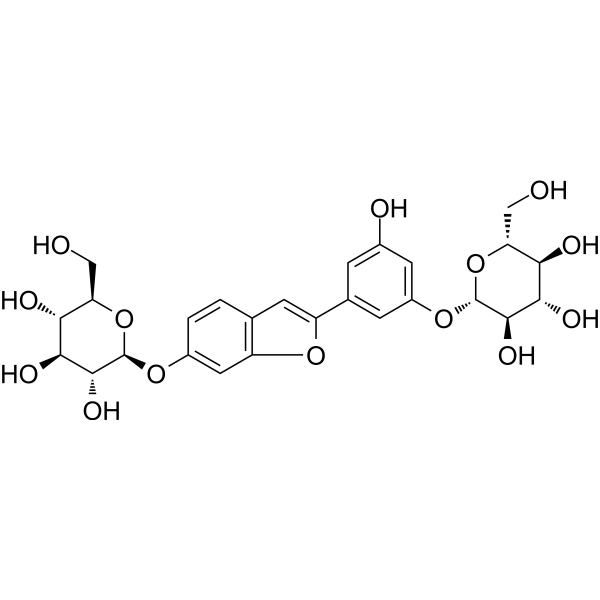
Mulberroside F
CAS No. 193483-95-3
Mulberroside F( —— )
Catalog No. M31431 CAS No. 193483-95-3
Mulberroside F shows inhibitory effects on tyrosinase activity and on the melanin formation of melan-a cells, it also exhibits superoxide scavenging activity that is involved in the protection against auto-oxidation, suggests that mulberroside F may be used as a skin whitening agent.
Purity : >98% (HPLC)
 COA
COA
 Datasheet
Datasheet
 HNMR
HNMR
 HPLC
HPLC
 MSDS
MSDS
 Handing Instructions
Handing Instructions
| Size | Price / USD | Stock | Quantity |
| 10MG | 247 | In Stock |


|
| 50MG | Get Quote | In Stock |


|
| 100MG | Get Quote | In Stock |


|
Biological Information
-
Product NameMulberroside F
-
NoteResearch use only, not for human use.
-
Brief DescriptionMulberroside F shows inhibitory effects on tyrosinase activity and on the melanin formation of melan-a cells, it also exhibits superoxide scavenging activity that is involved in the protection against auto-oxidation, suggests that mulberroside F may be used as a skin whitening agent.
-
DescriptionMulberroside F shows inhibitory effects on tyrosinase activity and on the melanin formation of melan-a cells, it also exhibits superoxide scavenging activity that is involved in the protection against auto-oxidation, suggests that mulberroside F may be used as a skin whitening agent.
-
In Vitro——
-
In Vivo——
-
Synonyms——
-
PathwayOthers
-
TargetOther Targets
-
Recptor——
-
Research Area——
-
Indication——
Chemical Information
-
CAS Number193483-95-3
-
Formula Weight566.5
-
Molecular FormulaC26H30O14
-
Purity>98% (HPLC)
-
Solubility——
-
SMILES——
-
Chemical Name——
Shipping & Storage Information
-
Storage(-20℃)
-
ShippingWith Ice Pack
-
Stability≥ 2 years
Reference
molnova catalog



related products
-
Nuclear Export Signa...
Nuclear Export Signal, NES, PKI
-
N-Acetyl lysyltyrosy...
N-Acetyl lysyltyrosylcysteine amide is a non-toxic, potent, reversible, and specific myeloperoxidase (MPO) tripeptide inhibitor that effectively inhibits MPO production in vivo, attenuates neuronal damage, preserves brain tissue and neurological function post-stroke, and inhibits MPO-dependent hypochlorite (HOCl) production, protein nitration, and LDL oxidation.
-
m-PEG9-CH2COOH
m-PEG9-CH2COOH is a PEG-based PROTAC linker that can be used in the synthesis of PROTACs.



 Cart
Cart
 sales@molnova.com
sales@molnova.com


